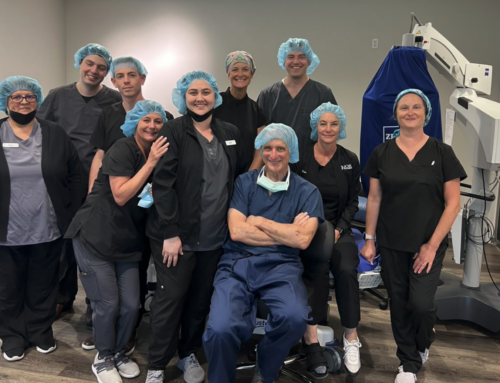
 Read this article on the AOA website –
Read this article on the AOA website –
More than one-third of Americans have presbyopia, a gradual loss of near vision with age. Most people reach for eyeglasses or specialty contact lenses, but these are easily lost or can seem burdensome. Now, a promising nonsurgical treatment for presbyopia is on the horizon: topical eye drops.
Two kinds of eyedrops
Presbyopia occurs when the clear lens of the eye stiffens over time and loses flexibility. This makes it hard to focus on words on a page or smartphone. Two types of eye drops — each with unique mechanisms – address this. Miotic drops make the pupil contract, limiting out-of-focus information. The first FDA-approved drop for presbyopia is a type of miotic drop. Lens-softening drops help restore the flexibility of the lens.
Miotic drops
Miotic drops change the size of the pupil and may also increase ciliary body tone. By creating a ‘pinhole effect’, this type of drop maximizes near and far focus. This is reminiscent of an original film camera before the invention of the lens. Allergan released the first FDA-approved miotic drop treatment for presbyopia in 2021.
“The significance of this FDA approval is massive as there are approximately 2 billion people worldwide with presbyopia. Glasses, contact lenses, and surgery are traditional treatments, but, for various reasons, do not work well for every patient,” said Christopher Starr, ophthalmologist at Weill Cornell Medicine in New York City. “Having a novel treatment option in the form of a presbyopia eye drop is a welcome addition to our armamentarium against this universal age-related near vision condition that effects essentially everyone over the age of 40.”
Lens-softening drops
This type of drop softens the eye’s aging lens. When the lens regains flexibility, the eye can better focus on near objects. Lens-softening drops cannot completely restore near vision. But they may be able to turn back the clock by up to 10 years. This type of drop may work best for people without cataracts who are in the beginning stages of presbyopia. That includes nearly half of people diagnosed with the condition. Novartis has developed the first lens-softening drop, and it is currently in phase 2 trials.
Will drops work as well as glasses?
Recent studies suggest that miotic drops begin working in about 30 minutes and last four to seven hours. Once the corrective effect wears off, the drops must be reapplied. By contrast, lens-softening drops may continue working for several years. Individuals using either type of drops have gained up to 7 lines of near vision – as much as they would with reading glasses. Some people taking the drops developed a headache, limited night vision or trouble distinguishing an object from its background.
Some patients may be able to use a combination of miotic and lens-softening drops to maximize vision. Others may benefit more from one type of drop than the other. If you have an early cataract, for example, creating a pinhole effect could make your vision even worse. That’s why it is important to have a comprehensive eye exam to evaluate eye health.
How much will the drops cost?
It is unlikely that any of these eyedrops will be covered by insurance. However, some patients — those who need bifocals or multifocals, or those who prefer designer frames with bells and whistles — may find that the drops are the least expensive presbyopia treatment over time.
What about eye surgery?
Some people may also have an option to correct presbyopia with eye surgery. Surgeries for presbyopia correction include intraocular lens implantation, corneal inlays, and laser refractive surgery (LASIK). Not everyone is candidate for these procedures, however. Additionally, these surgeries can cost thousands of dollars—a price tag that is prohibitive for many patients.
“Eye drops will offer a meaningful and cost-effective choice for many who live with presbyopia. But it’s important to remember that there is no one-size-fits-all treatment. Every person’s eyes are unique — and glasses, drops and surgery all have their pros and cons. A comprehensive eye examination by an ophthalmologist will help you find the option that’s best for you,” advises Luke Rebenitsch, medical director and refractive surgeon at ClearSight Center in Oklahoma City.
 Our practice philosophy at Barth Vision & Optical is simple, though we like to think it reflects a profound sentiment. We are here to be of service, in the truest sense of the term. We offer State-of-the-art eye examinations, A unique collection of fashion eye wear, Cataract surgery & consultation, LASIK vision correction, Eye Care Telemedicine. Call Today for an Appointment (707) 955-1120.
Our practice philosophy at Barth Vision & Optical is simple, though we like to think it reflects a profound sentiment. We are here to be of service, in the truest sense of the term. We offer State-of-the-art eye examinations, A unique collection of fashion eye wear, Cataract surgery & consultation, LASIK vision correction, Eye Care Telemedicine. Call Today for an Appointment (707) 955-1120.


